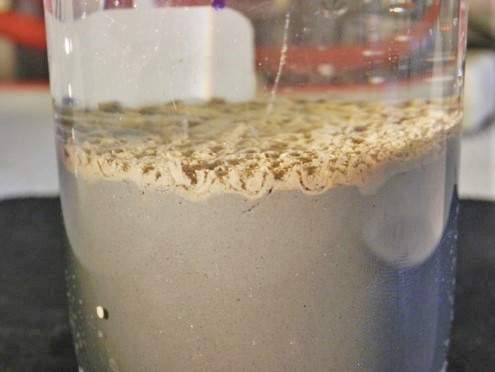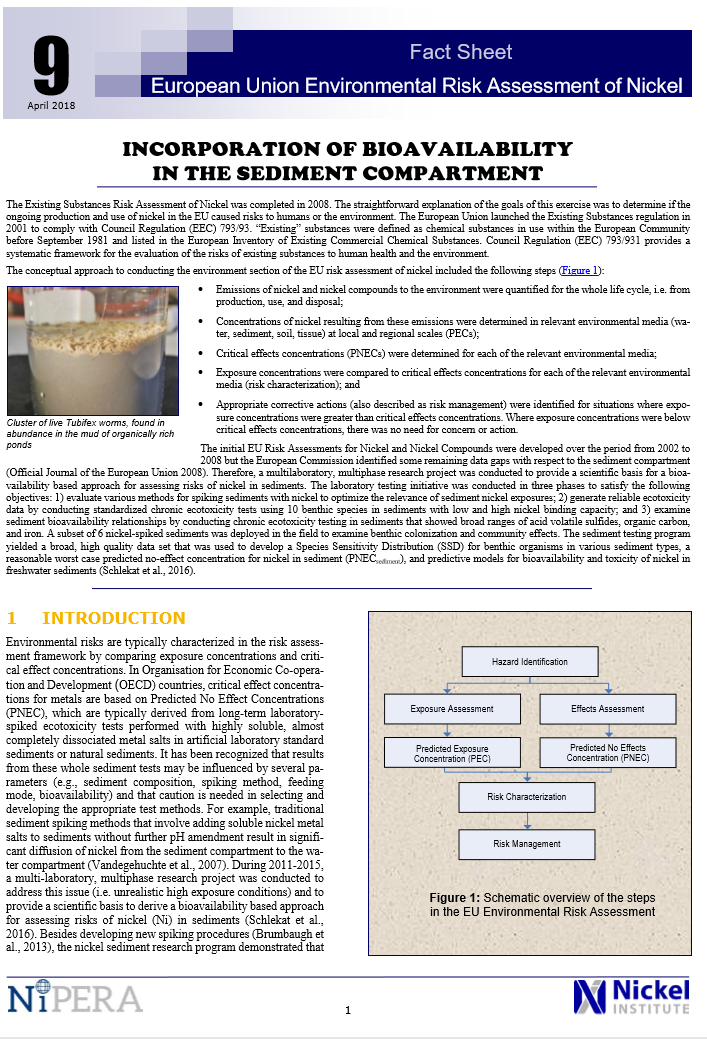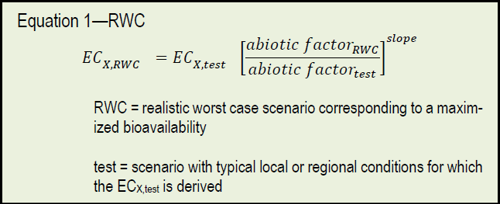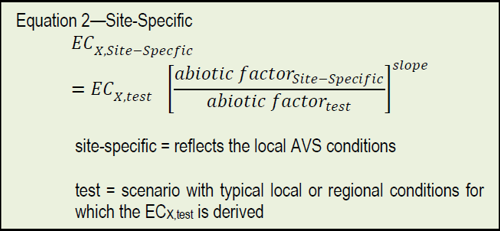Allen, H.E.; Fu, G.; Boothman, W.; DiToro, D.; Mahony, J.D. 1991. Draft analytical method for determination of acid volatile sulfide in sediment. U.S. Environmental Protection Agency. Washington, DC.
Allen, H.E.; Fu, G.; Deng, B. 1993. Analysis of acid-volatile sulfide (AVS) and simultaneously extracted metals (SEM) for the estimation of potential toxicity in aquatic systems. Environmental Toxicology and Chemistry 12: 1441-1453.
Ankley, G.T.; Phipps, G.L.; Leonard, E.N.; Benoit, D.A.; Mattson, V.R.; Kosian, P.A.; Cotter, A.M.; Dierkes, J.R.; Hansen, D.J.; Mahony, D.J. 1991. Acid Volatile sulfide as a factor mediating cadmium and nickel bioavailability in contaminated sediments. Environmental Toxicology and Chemistry 10: 1299-1307.
Ankley, G.T.; Di Toro, D.M.; Hansen, D.J.; Berry, W.J. 1996. Technical basis and proposal for deriving sediment quality criteria for metals. Environmental Toxicology and Chemistry 15(2): 2056-2066.
Besser, J.M.; Brumbaugh, W.G.; Ingersoll, C.G.; Ivey, C.D.; Kunz, J.L.; Kemble, N.E.; Schlekat, C.E.; Garman, E.R. 2013. Chronic toxicity of nickel-spiked freshwater sediments: Variation in toxicity among eight invertebrate taxa and eight sediments. Environmental Toxicology and Chemistry 32: 2495-2506.
Brumbaugh, W.G.; Hammerschmidt, C.R.; Zanella, L.; Rogevich, E.; Salata, G.; Bolek, R. 2011. Interlaboratory comparison of measurements and Acid-Volatile Sulfide and Simultaneously Extracted Nickel in spiked sediments. Environmental Toxicology and Chemistry 30(6): 1306-1309.
Brumbaugh, W.G.; Besser, J.M.; Ingersoll, C.G.; May, T.W.; Ivey, C.D.; Schlekat, C.E.; Rogevich-Garman, E. 2013. Nickel partitioning during chronic laboratory toxicity tests with eight different spiked freshwater sediments: Toward more environmentally realistic testing conditions. Environmental Toxicology and Chemistry 32: 2482–2494.
Burton, G.A.; Green, A.; Bauso, R.; Forbes, V.; Nguyen, L.T.; Janssen, C.R.; Kukkonen, J.; Leppanen, M.; Maltby, L.; Soares, A.; Kapo, K.; Smith, P.; Dunning, J. 2007. Characterizing sediment acid volatile sulfide concentration in European streams. Environmental Toxicology and Chemistry 26(1): 1-12.
Buykx, S.E.J.; Bleijenberg, M.; van den Hoop, M.A.G.T.; Loch, J.P.G. 2000. The effect of oxidation and acidification on the speciation of heavy metals in sulfide-rich freshwater sediments using a sequential extraction procedure. Journal of Environmental Monitoring 2: 23-27.
Costello, D.M.; Burton, G.A.; Hammerschmidth, C.R.; Rogevich, E.C.; Schlekat, C.E. 2011. Nickel phase partitioning and toxicity in field deployed sediments. Environmental Science and Technology 45(13): 5798-57805.
De Lange, H.J.; Van Griethuysen, C.; Koelmans, A.A. 2008. Sampling method, storage and pretreatment of sediment affect AVS concentrations with consequences for bioassay responses. Environmental Pollution 151: 243-251.
Di Toro, D.M.; Mahony, J.D.; Hansen, D.J.; Scott, K.J.; Carlson, A.R., Ankley, G.T. 1992. Acid volatile sulfide predicts the acute toxicity of cadmium and nickel in sediments. Environmental Science Technology 26: 96-101.
Grabowski, L.A.; Houpis, J.L.J.; Woods, W.I.; Johnson, K.A. 2001. Seasonal bioavailability of sediment-associated heavy metals along the Mississippi river flood plain. Chemosphere 45: 643-651.
Hammerschmidt, C.R.; Burton, G.A. 2010. Measurements of acid volatile sulfide and simultaneously extracted metals are irreproducible among laboratories. Environmental Toxicology and Chemistry 29(7): 1453-1456.
Howard, D.E.; Evans, R.D. 1993. Acid-volatile sulfide (AVS) in a seasonally anoxic mesotrophic lake: Seasonal and spatial changes in sediment AVS. Environmental Toxicology and Chemistry 12: 1051-1057.
Morse, J.W. 2004. Chemical dynamics of sedimentary acid volatile sulfide. Environmental Science and Technology 1(38) 7:131-136.
Peterson G.S., Anklet, G.T.; Leonard, E.N. 1996. Effect of bioturbation on metal-sulfide oxidation in surficial freshwater sediments. Environmental Toxicology and Chemistry 15(12): 2147-2155.
Poot, A.; Gillssen. F.; Kolemans, A.A. 2007. Effects of flow regime and flooding on heavy metal availability in sediment and soil of a dynamic river system. Environmental Pollution 148(3): 779-787.
Schlekat, C.E.; Garman, E.R.; Vangheluwe, M.L.; Burton, G.A. 2016. Development of a bioavailability-based risk assessment approach for nickel in freshwater sediments. Integrated Environmental Assessment and Management DOI: 10.1002/ieam.1720.
Van Den Berg, G.A.; Loch, J.P.; Van Der Heijdt, L.M.; Zwolsman, J.G. 1998. Vertical distribution of acid volatile sulfide and simultaneously extracted metals in a recent sedimentation area of the river Meuse in the Netherlands. Environmental Toxicology and Chemistry 17(4): 758-763.
Van den Berg, G.A.; Buykx, S.E.J.; Van Den Hoop, M.A.G.T.; Van Der Heijdt, L.M.; Zwolsman, J.J.G. 2001a. Vertical profiles of trace metals and acid-volatile-sulfide in a dynamic sedimentary environment: Lake Ketel, The Netherlands. Applied Geochemistry 16: 781-791.
Van Den Berg, G.A.; Meijers, G.G.; Van Der Heijdt, L.M.; Zwolsman, J.J. 2001b. Dredging related mobilisation of trace metals: a case study in the Netherlands. Water Research 35(8): 1979-1986.
Van den Hoop, M.A.G.T.; den Hollander, H.A.; Kerdijk, H.N. 1997. Spatial and seasonal variations of acid volatile sulphide (AVS) and simultaneously extracted metals (SEM) in Dutch marine and freshwater sediments. Chemosphere 35(10): 2307-2316.
Vandegehuchte, M.B.; Roman, Y.E.; Nguyen, L.T.; Janssen, C.R.; De Schamphelaere, K.A. 2007. Toxicological availability of nickel to the benthic oligochaete Lumbriculus variegatus. Environmental International 33: 736-742.
Vangheluwe 2005. Discussion document on the selection of an AVS default value representative for the EU region, 25th November 2005.
Vangheluwe, M.; Verdonck, F.; Heijerick, D.; Shtiza, A.; Burtin, A.; Taulbee K.; Boucard, T.; Mäkinen, J.; Gonzales, E. 2008. Acid volatile sulfide survey of large river and/or lake sediments in the United Kingdom (England and Wales) Spain and Finland in 2007. ARCHE Consulting. Final report September.
Vangheluwe, M.L.U.; Verdonck, F.A.M.; Besser, J.M.; Brumbaugh, W.G.; Ingersoll, C.G.; Schlekat, C.E.; Garman, E.R. 2013. Improving sediment quality guidelines for nickel: Development and application of predictive bioavailability models to assess chronic toxicity of nickel in freshwater sediments. Environmental Toxicology and Chemistry 32: 2507-2519.
Vangheluwe, M.; Nguyen L. 2015. Advanced research on nickel toxicity in sediments: results additional species and modeling. Final Report. Durham (NC): Nickel Producers Environmental Research Association.




